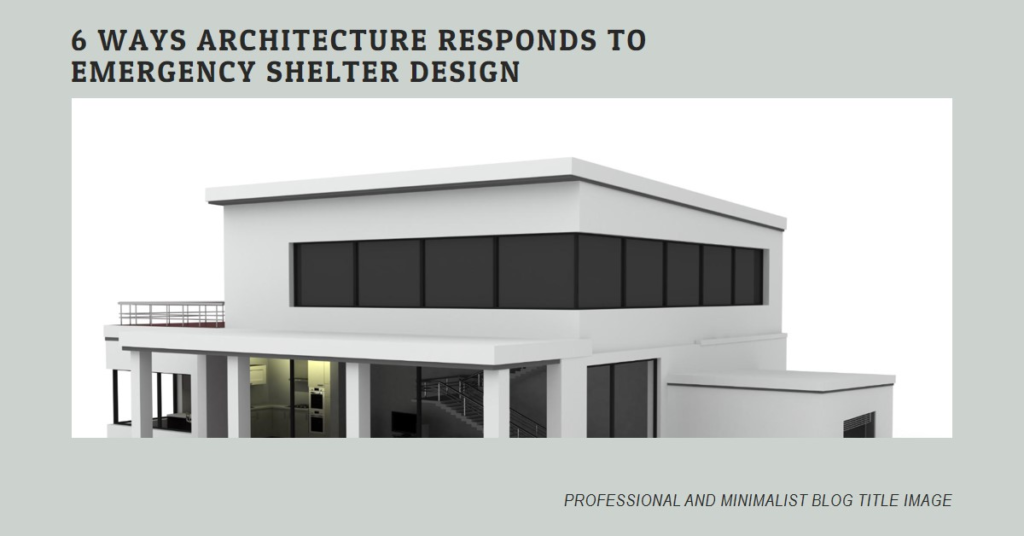
Table of Contents
Emergency Shelter Design, Architecture plays a crucial role in addressing humanitarian crises and providing shelter solutions in emergency situations worldwide. From natural disasters to conflicts and refugee crises, architects are utilizing innovative strategies and design principles to create safe, durable, and dignified shelter options for displaced populations. In this comprehensive blog post, we will explore six key ways architecture is dealing with emergency shelter design, showcasing the industry’s commitment to humanitarian aid and sustainable solutions.
1. Rapid Deployment Systems: Swift Response to Crisis (Emergency Shelter Design)
One of the primary challenges in emergency shelter design is the need for rapid deployment and scalability to accommodate large displaced populations quickly. Architects are developing innovative rapid deployment systems that utilize prefabricated components, modular designs, and lightweight materials for easy transportation and assembly in crisis zones.
These systems often incorporate foldable structures, interlocking panels, and adaptable layouts that can be customized based on site conditions and user needs. By leveraging prefabrication technologies and efficient logistics, architects ensure swift response times during emergencies, providing essential shelter solutions to vulnerable communities in a timely manner.
2. Sustainable Materials and Technologies: Eco-Friendly Solutions
Incorporating sustainable materials and technologies into emergency shelter design not only reduces environmental impact but also enhances durability, energy efficiency, and long-term resilience. Architects are exploring renewable materials such as bamboo, recycled plastics, and engineered composites that offer lightweight, sturdy, and eco-friendly shelter components.
Integration of passive design strategies, solar panels, rainwater harvesting systems, and natural ventilation techniques improves shelter comfort levels while minimizing reliance on external resources. Sustainable shelters not only meet immediate shelter needs but also contribute to sustainable development goals, promoting environmental stewardship and resource efficiency in humanitarian interventions.
3. Modular and Flexible Design Concepts: Adaptive Spaces
Flexibility and adaptability are key principles in designing emergency shelters that can accommodate evolving needs and diverse user groups over time. Architects are creating modular shelter designs that allow for easy expansion, reconfiguration, and repurposing of spaces based on changing family sizes, community dynamics, and functional requirements.
Modular components such as partition walls, furniture systems, and multi-use spaces enhance spatial efficiency, privacy, and user comfort within limited footprint areas. Designing for adaptability ensures that emergency shelters remain functional and relevant beyond initial crisis stages, supporting long-term recovery and community resilience efforts.
4. Community-Centric Design Approaches: Participatory Design
Engaging affected communities, stakeholders, and local builders in the design process fosters community ownership, cultural relevance, and social cohesion in emergency shelter projects. Architects are adopting participatory design approaches that prioritize community input, cultural sensitivities, and local building traditions to create shelters that resonate with user needs and preferences.
Workshops, co-design sessions, and collaborative planning processes empower displaced populations to contribute ideas, preferences, and feedback on shelter designs, layouts, and materials. By integrating local knowledge, skills, and resources, architects create dignified and contextually appropriate shelter solutions that reflect community identities and aspirations.
5. Transitional Housing Solutions: Beyond Temporary Shelters
Transitioning from emergency shelters to more permanent housing solutions is a critical aspect of post-disaster or post-conflict reconstruction efforts. Architects are designing transitional housing models that bridge the gap between emergency shelters and permanent residences, offering durable, safe, and affordable housing options for displaced families during recovery phases.
These transitional housing designs often incorporate durable materials, improved insulation, basic amenities, and community infrastructure elements such as shared spaces, sanitation facilities, and green areas. By considering long-term livability, safety standards, and cultural preferences, architects contribute to holistic recovery strategies that empower communities and restore dignified living conditions.
6. Technological Innovations: Digital Tools and Data-driven Design
Advancements in digital tools, computational design, and data-driven approaches are revolutionizing emergency shelter design processes and outcomes. Architects are using geographic information systems (GIS), parametric modeling, and 3D scanning technologies to assess site conditions, plan shelter layouts, and optimize structural designs for safety and efficiency.
Simulation software, virtual reality (VR), and augmented reality (AR) tools facilitate design visualization, stakeholder engagement, and user experience testing, ensuring shelter designs meet functional, ergonomic, and cultural requirements. Leveraging real-time data analytics, remote monitoring systems, and IoT (Internet of Things) sensors in shelters enhances operational efficiency, safety monitoring, and maintenance protocols in humanitarian settings.
7. Collaboration with Humanitarian Organizations: Expertise Exchange
Collaboration between architectural firms, humanitarian organizations, NGOs, and governmental agencies is essential for leveraging expertise, resources, and best practices in emergency shelter design and implementation. Architects partner with aid organizations to understand field realities, local regulations, and community needs, aligning design solutions with humanitarian standards and guidelines.
Joint initiatives, knowledge-sharing platforms, and capacity-building programs enable architects to contribute effectively to humanitarian response efforts, disaster risk reduction strategies, and sustainable shelter interventions. By fostering interdisciplinary collaborations and shared learning, architects play a vital role in shaping resilient, inclusive, and dignified shelter solutions for vulnerable populations worldwide.
8. Accessibility and Inclusivity: Universal Design Principles
Integrating universal design principles into emergency shelter projects ensures accessibility, inclusivity, and dignity for all occupants, including persons with disabilities, elderly individuals, and marginalized groups. Architects prioritize barrier-free access, ergonomic layouts, and adaptable features such as ramp systems, accessible toilets, and sensory-friendly environments within shelters.
Consultations with accessibility experts, disability rights organizations, and community advocates inform design decisions that promote independence, safety, and well-being for diverse user groups. Inclusive shelter designs not only comply with international accessibility standards but also uphold human rights principles, fostering respect, equality, and empowerment in emergency response contexts.
9. Cultural Preservation and Identity: Contextual Sensitivity
Respecting cultural heritage, traditions, and identities is integral to designing shelters that resonate with displaced communities’ sense of belonging and identity. Architects collaborate with anthropologists, cultural experts, and community leaders to understand cultural norms, spatial practices, and symbolic meanings embedded in built environments.
Design elements such as vernacular architecture influences, traditional craftsmanship, and culturally significant motifs are incorporated into shelter designs, respecting local aesthetics and architectural vocabularies. By preserving cultural heritage and identity in shelter designs, architects contribute to community resilience, cultural continuity, and psychosocial well-being among displaced populations.
10. Post-Occupancy Evaluation and Feedback: Continuous Improvement


Conducting post-occupancy evaluations (POEs) and gathering user feedback on shelter designs and functionality inform iterative improvements, lessons learned, and best practices for future emergency shelter projects. Architects collaborate with humanitarian agencies, researchers, and local communities to assess shelter performance, user satisfaction, and adaptation challenges over time.
Feedback mechanisms such as surveys, focus group discussions, and participatory assessments capture user experiences, preferences, and suggestions for design enhancements or modifications. Incorporating lessons learned from POEs into design guidelines, training programs, and policy frameworks promotes continuous improvement, innovation, and quality assurance in emergency shelter design practices.


